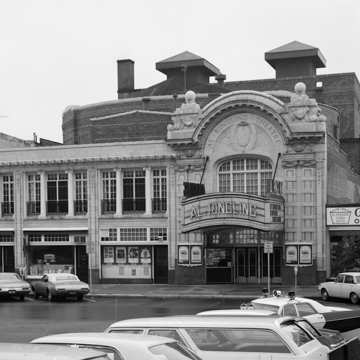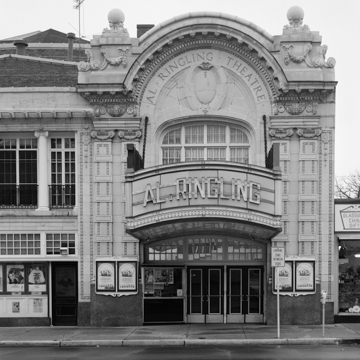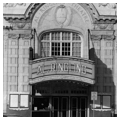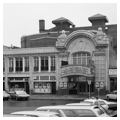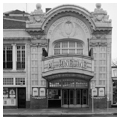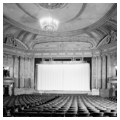During the 1910s and 1920s, movie theaters were, in a word, theatrical. Theater designers created extravagant fantasies, with dazzling interiors embellished with murals, chandeliers, monumental staircases, rich draperies, Baroque plasterwork, and silver- and gold-leafed walls and ceilings. For the price of a movie ticket, spectators could be swept out of the drab workaday world into an atmosphere of splendor.
In 1915, Albrecht Ringling engaged George and Cornelius Rapp to create a magnificent movie palace. Among the preeminent American theater designers, Rapp and Rapp had unabashed grandeur as their stock-in-trade. For Ringling, the Rapps created a two-story, Beaux-Arts classical, terra-cotta-clad building. A triumphal arch supported by paired Ionic pilasters draped with garlands elaborates the entrance and terminates in festooned pedestals. Below the tympanum in the arch, a broad elliptical-arched window lights the lobby. To one side of the elaborate entrance extends a row of storefronts with offices above. Ornate pilasters and Ionic columns define the window bays, and French doors at the second level open onto iron balconets.
The lobby, a small elliptical room with a checkerboard-tiled floor, has pilasters crowned by a rosetted and garlanded capital dividing the lobby walls into eight bays. Above is an exuberant multilayered terra-cotta frieze of undulating plant motifs supporting a series of sculptures copied from a frieze by Luca della Robbia for the Cathedral of Florence. Polychromatic flower baskets, cast in high relief, grace each end of the wide, ornate cove ringing the ceiling. The ceiling’s painted field depicts the sky with cherubs floating among the clouds.
The 804-seat auditorium is an awesome space, with gold-leaf surfaces and a painted ceiling inspired by the Opera House at Versailles. Murals portraying cherubs and allegorical depictions of Joy, Delight, and other pleasurable emotions line the cove along the ceiling. These are the work of G. A. Brand of Chicago. Engaged Corinthian columns separate the projecting semi-elliptical theater boxes used during live theatrical productions. Rinceaux, cartouches, and rope moldings ornament each of fifteen boxes. Even more ornate are the proscenium boxes, which have gilded balustrades and semicircular pediments. The fire curtain still bears a painting, Serenade au Petit Trianon (referring to the eighteenth-century residence at Versailles), created by the Sosman and Landes Company, scenic artists from Chicago. Wiley Brothers were the builders of the theater.
Al Ringling planned his theater to accommodate motion pictures as well as theatrical productions. Indeed, the Ringling was one of the first theaters in the nation constructed expressly to show movies. It opened on November 17, 1915, with a live performance of a comic opera, but within a week, silent movies, accompanied by a pipe organ, were flickering on the Ringling’s screen. Today, movies and live performances continue to transport visitors into magical worlds.



